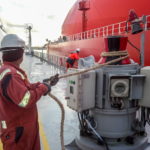Shipping is highly regulated and a lot of time is spent discussing the burden of rules and regulations imposed on shipping companies. Most new regulations aim to increase safety at sea yet recent reports point to an increase in the accident rate, so why is this happening?
It is how regulations are implemented which is crucial and to achieve that you need proper training, implementation of best[ds_preview] practices, good seamanship, consistency in the interpretation of the regulations and in-depth auditing processes.
In addition, our experience at »Prevention at Sea« shows that the vast majority of regulations do not consider the importance of the human element. Resistance to change is a natural human phenomenon so what is being done to help seafarers adapt to regulatory changes?
We feel that a key part is an effective methodical risk assessment approach paying attention to the human element and real-life situations.
When the concept of risk assessment was introduced in the shipping industry in 2010 through the ISM Code, the industry believed the requirement would be covered by putting in place procedures incorporating a risk matrix based on consequence »X« probability. The risk matrices designed at that time involved generic descriptions of both consequence and probability; the aim being to cover complex tasks from different fields.
Although slightly modified over the years, this model still remains as the main tool for the calculation of risk on board ships and ashore. Why? Because mariners and shipping professionals were trained on and required, through the established management procedures, to implement such a methodology.
Crew are normally present when a ship is audited and they will use, as their main tool for the calculation of risks, a library of predefined risk assessment cases that have pre-determined risks and the corresponding pre-calculated consequence »X« probability.
Controls for risk mitigation or elimination are also available in each predetermined risk case. Therefore, whenever a new task is assigned and requires risk evaluation, crew will refer to those predefined cases and proceed to the job without going through a real-life risk assessment process.
Those risk assessment libraries have either been prepared in-house or are available via software products revolving around risk assessments which have developed to meet the ISM and TMSA requirements. The problem with these software products is that they only help the mariners prepare a risk assessment focused on one task in isolation rather than additional tasks or works carried out at the same time; in other words what auditors encounter on board is task based risk assessments instead of an overall risk assessment.
It is this real-life assessment process which might draw attention to new and hidden risks or to escalating ones. Records over the past few years show that, despite the regulated implementation of risk assessment, incidents are on the increase. This is down to risks that arise due to unfamiliarity and lack of training on new technologies as well as new or amended regulations, lack of best practices, lack of good seamanship, demanding and time-pressured ship operations, and not forgetting the human element.
Daily tasks are complex
But the daily tasks of shipping operations are complex; hence it is crucial to adopt a risk methodology which takes into consideration the complexity of doing simultaneous tasks and the potential risks involved when taking all these tasks into consideration at the same time.
We can point to a lot of examples, using our real-life risk assessment methodology, where the owner/manager has been saved from a major incident that could have caused either a lot of expenditure, long delays and potential fines at ports. Those examples involve bad practices, wrong records, falsification, poor operations, etc.
Ship managers and operators tend to believe that risk assessment is a process that can be covered internally by their in-house team – i.e. the superintendent, captain or engineer, due to their significant experience at sea. But is this adequate?
Are the following points taken into consideration whenever a major task is about to commence?
Is a real-life risk assessment conducted before the task?
If yes, does the subject methodology take into consideration all neighbouring tasks happening at the same time or ones that will soon be commencing, as well as the surrounding conditions and ship’s state?
How is it ensured that the risk assessment applies to the actual surrounding conditions at the time the task is planned to take place e.g. not doing a risk assessment in the daylight when the task is happening at night?
How is it ensured that all evolving tasks have been taken into consideration or reported by crew members on board?
How is objectivity ensured when the risk assessment is carried out in-house?
Is the risk methodology constantly being updated?
The shipping industry has begun to realise that the current risk methodology is not effective and efficient, as it involves generic procedures and focuses on one task at a time.
An online survey by Prevention at Sea suggests that participants are happy to invite a third party on board or ashore for risk assessment purposes as they feel the assessor will help them to understand potential problems before they become serious issues and offer rectifying solutions.
By providing a new risk assessment approach, we work with the auditee to help ensure the smooth operation of the fleet and enhance best management practices.
Through our network of risk assessors, we deliver modern risk assessments for quality assurance that efficiently covers vetting, insurance, internal, and funding purposes etc. while we aim to identify hidden risks before they escalate.
We assist mariners, while on board, to fully understand the potential issues by never »pointing the finger« of blame. On the contrary, we advise them what to do as well as train them by always referring to best shipping practices and adherence to regulations. The client receives comprehensive reports, full statistical analysis of our findings and our suggestions for rectification and improvements including follow-ups if required.
We recommend that a ship is risk-assessed every four to five months particularly to co-inside with crew changeovers. We also strive for constructive cooperation with international organisations to clarify the interpretation of regulations and advise our clients and risk assessors accordingly.
Integrated solution
At the same time, we design in-house software products that not only address one reported problem on board ships, which very often derives from the wrong implementation of the rules, but also a combination of issues which are not always visible at first sight. This is achieved by analysing thoroughly the root cause and then designing user friendly solutions that will not add burden to seafarers.
We are currently designing an integrated solution to permanently solve the challenging issue of the »magic« while we are also in the process of designing a software package involving full assessment and management of risks happening simultaneously. Better prevent an incident happening in the first place than deal with the consequences which could be costly and damaging to your reputation.
Petros Achtypis




















